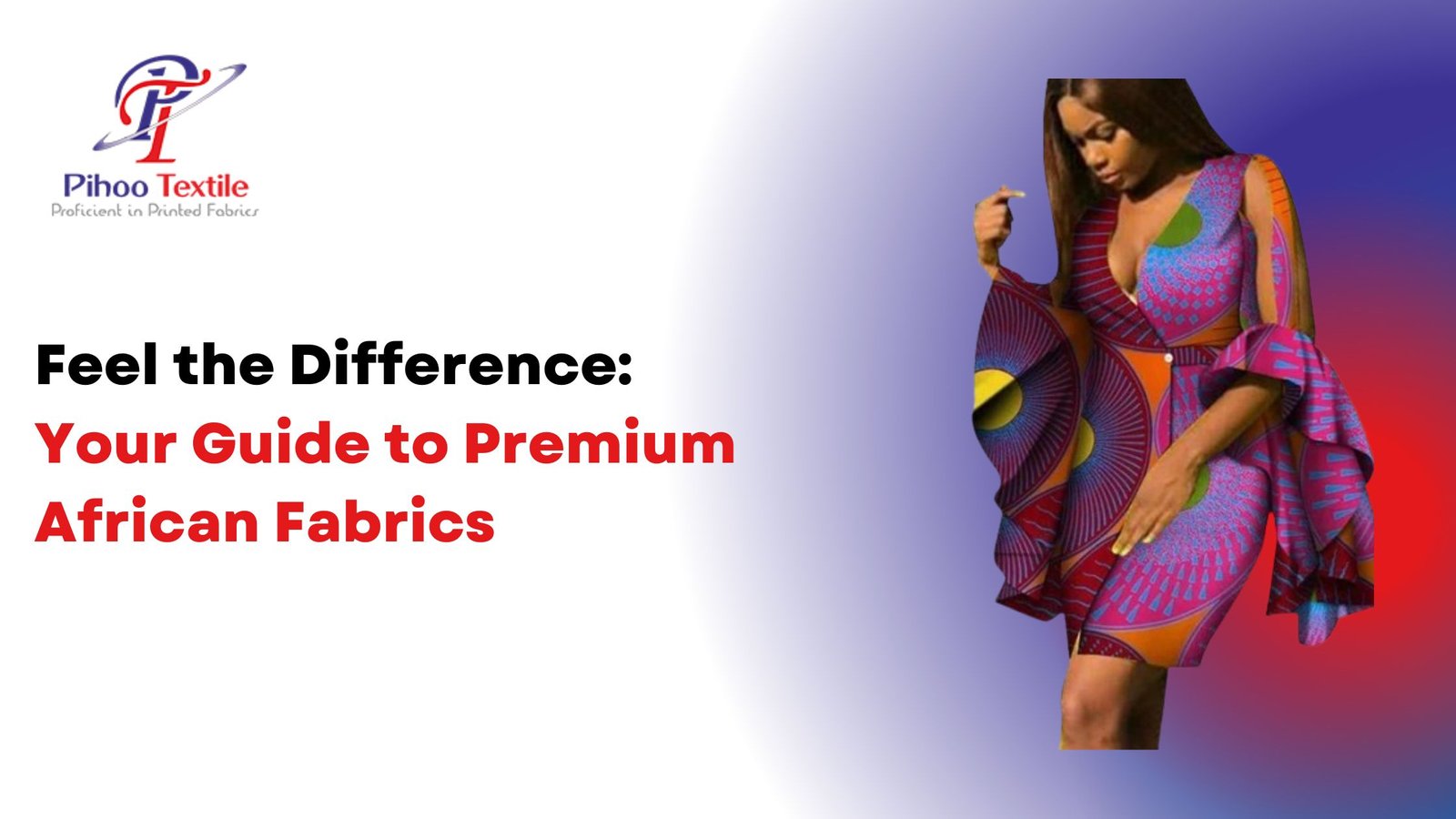Feel the Difference: Your Guide to Premium African Fabrics
Feel the Difference: Your Guide to Premium African Fabrics
Here’s the tension: “African” wax prints are global icons—yet the premium end is wildly misunderstood. As one designer bluntly notes, “They were first produced in the 1800s by the Dutch as an attempt to copy and mass-produce hand-drawn wax resist Indonesian batiks.” West Africa didn’t just adopt them; it made them culturally definitive. If you’re sourcing what your customer will call premium, you need clarity on provenance, process, and proof. Pihioo Textile sits in this space in India—manufacturing African-inspired prints with the kind of repeatability and documentation premium buyers demand—so we’ll be unsentimental about what matters (even beyond us). (Craft Industry Alliance)
What “Premium” Actually Means?
“Premium” is not a vibe; it’s a stack of verifiable choices. On the brand side, Vlisco describes its hallmark as “rooted in the Indonesian wax-based batik technique,” with product families like Wax Hollandais, Super-Wax, and Grand Super-Wax forming the canonical tiers. Read that as a spectrum of handle, finish, and complexity—not just price. (Vlisco)
Parallel luxury streams appear in West African dress fabrics—Bazin Riche (a high-status cotton damask/brocade, long linked to Austrian makers and sub-Saharan dye traditions) and Swiss voile lace (lightweight, embroidered cotton, typically sold in 5-yard cuts). If your brief says ceremonial, heirloom, or statement, you’re playing in these waters. (TRC Leiden, Jansen Holland)
Line to remember: Premium is process you can prove, not adjectives you can print.
The Origin Story that Shapes Quality
Forget the myth that “authentic” always means “handmade in place.” The supply chain is hybrid by design. Vlisco’s own history is explicit—founded in 1846 with techniques anchored in Indonesian batik, later entwined with West and Central African markets. That hybridity created today’s premium signals: the crisp cotton body; the optical “bubble” in Super-Wax; the story-laden motifs. (Vlisco)
If you need a cultural decoder ring, a good working definition is: batik roots, West African meaning, industrial rigor. (And yes, that mix is why “premium” has both emotional and technical components.)
Fabric Classes—and Why They Feel Different
- Wax Hollandais: the “original” premium cotton block print—“strong and full-bodied feel” is the brand’s own language. Expect a clear hand, 120 cm width norms, and deep color stability when care is followed. (Vlisco)
- Super-Wax: signature two-tone “bubble effect,” slightly different handle (often described as crisper/shinier), positioned above Wax Hollandais on complexity. If your collection needs that eye-catching micro-texture in the dye rings, you’re here. (Vlisco)
- Grand Super-Wax / Satin lines: think elevated finish and visual drama; useful for occasionwear or hero garments that carry a lookbook. (Vlisco)
- Bazin Riche (Brocade/Damask): “Premium: a damask made from superior quality cotton thread and with a closely woven design,” notes the Textile Research Centre (Leiden). Historically dyed in vibrant tones, then tailored into formal garments (boubou, kaftans). Buy for sheen, drape, and status signaling. (TRC Leiden)
- Swiss Voile Lace: lightweight, embroidered, 100% Swiss cotton voile, commonly in 5-yard cuts—a go-to for premium ceremonial attire. The value here is in embroidery precision and the soft, breathable hand. (Jansen Holland)
How Premium Wax Prints Are Made (and Why It Matters)?
The core is wax-resist logic: apply wax; dye; remove; repeat—stacking color and detail in stages. Vlisco foregrounds this as part of its identity: “crafted using time-honoured methods and quality materials, rooted in the Indonesian wax-based batik technique.” You’re paying for multi-stage control: registration, dye chemistry, and finish consistency. (Vlisco)
Buyer translation: premium process yields premium behavior—color that reads rich without bleeding, edges that don’t fuzz under micro-inspection, and a hand that feels “alive” rather than papery.
Authenticity & Quality Checks (No Guesswork)
1) Double-sided color logic. In true wax processes, penetration shows on the reverse; single-side surface prints often read flatter. (Use this as a quick-look triage, then verify.)
2) Selvage language. Heritage mills stamp selvages with product/brand marks (e.g., “Wax Hollandais,” design names). Treat selvage as the label you can’t misplace. (Vlisco)
3) Security codes. West African brands weaponize anti-counterfeit tech: “Rub off a scratch layer… SMS the PIN code to 1393… receive response confirming or denying the validity.” If your marketing leans on “original,” your procurement must insist on codes—or you sell honestly as inspired prints. (Engineering For Change, Afrothreads)
4) Hand, weight, and finish. Premium cottons carry body without boardiness; poor counterfeits feel plasticky or rigid.
Zinger: If the selvage tells no story, the invoice will tell a sad one later.
Buying Units & Cuts (Plan for Reality)
The market speaks in pieces: “12 yards (full piece) or 6 yards (half piece)” is the longstanding norm across brands and resellers; many e-commerce and wholesale listings mirror it. Calibrate your tech packs and cutting markers to those unit realities; don’t design garments that die on the cutting table. (Wikipedia, Urbanstax)
Where to Buy Premium (Signals, Not Shout-outs)?
You don’t need a directory of links—you need filters. Brand-direct hubs (e.g., Vlisco for Wax Hollandais/Super-Wax; European/Austrian sources for Bazin Riche; established Swiss-voile houses for lace) are useful because they publish the trust scaffolding: Points of Sale, wholesale terms, shipping/returns, and explicit product families. If a seller cannot show parity on documentation, pricing alone won’t save you. (Vlisco)
Care & Longevity (Keep the Finish, Keep the Feel)
Premium doesn’t babysit itself. “Limited program at 30–40 °C… wash inside out… do not wring or twist… do not bleach.” That’s straight from brand care pages. Dry in shade; separate light/dark; expect up to ~5% cotton shrinkage. Color is chemistry plus discipline—abuse the fabric and you pay in saturation. (Vlisco)
Practical payoff: push sellers for fabric-specific care guidance on the PI (proforma invoice). If their advice conflicts with recognized brand care norms, you’ve learned something about their process (and risk).
Style & Use (Why Premium Feels Different On-Body)
Wax Hollandais and Super-Wax are print-led; let the motif breathe with modern cuts and neutral pairings. Bazin Riche reads as architectural sheen—use tailored silhouettes to let the surface do the talking. Swiss voile lace is the quiet luxury of touch and air; think ceremony and summer. The difference you feel is not abstract—it’s the physics of weave density, finishing chemistry, and design scale working with the body. (Vlisco)
Culture & Meaning (Names Matter)
Across West and Central Africa, iconic motifs carry nicknames, proverbs, and social subtext. Brand archives and “Classics” collections log these references—use them respectfully. Treat print names as narrative metadata, not just SKU labels; it’s part of the premium promise your customer is paying for. (Vlisco)
Skimmable Field Guide: 20-Second Listing Scan
Selvage talks → read it.
Update stamps → prove recency.
Width + GSM + cut length → align to markers.
Photos under neutral light → ask for 3 recent roll shots.
Return/claims policy → sanity-check timelines.
If anything’s vague, assume it’s hiding a cost. (Vlisco)
Conclusion—Feeling the Difference in Practice
Premium is a contract: cultural truth, technical process, and brand-level proof—delivered consistently. Start with the families (Wax Hollandais, Super-Wax, Bazin Riche, Swiss voile). Verify with selvage, security codes, and care logic. Design to the real units (6/12 yards). And partner with suppliers who publish their homework.
That’s where Pihoo Textile positions itself: African-inspired premium prints made in India with export-grade documentation, repeatable specs, and a sourcing experience designed for brands that take provenance seriously. Use this playbook to test us—or anyone. The customer doesn’t just see the difference. They feel it.
Quoted or referenced above (selected):
“They were first produced in the 1800s by the Dutch…” — Craft Industry Alliance. (Craft Industry Alliance)
Vlisco history and process: “rooted in the Indonesian wax-based batik technique… Founded in 1846.” plus product families. (Vlisco)
Super-Wax bubble effect description (brand language). (Vlisco)
Bazin Riche (damask) quality tiers — Textile Research Centre (Leiden). (TRC Leiden)
Swiss voile lace basics (5-yard, cotton) — retailer specification pages. (Jansen Holland)
6- and 12-yard norms — brand/market listings and guides. (Wikipedia, Urbanstax)
Care guidance — brand wash-care pages. (Vlisco)
Security verification — “SMS the PIN code to 1393” mPedigree/Goldkeys documentation; consumer-facing demos. (Engineering For Change, Afrothreads)
(~1,200–1,300 words)


